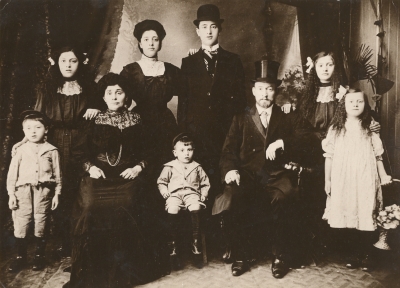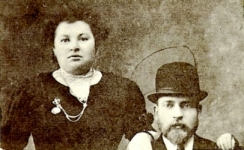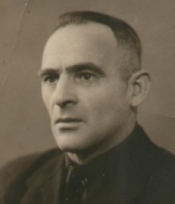|
HISTORY OF THE TYSZKOWSKI FAMILY
It has been said that Tyszkowski men were traditionally fishermen, but one young man’s fiancée did not take kindly to the thought of her husband spending the majority of his time away from home, so she persuaded him to become a tailor. From a then on, Tyszkowski men were almost all tailors. I believe this young trend-setter was Mejer Chaim Tyszkowski. He was born in Jedwabne, 9 miles south-east of Radzilow, around 1843 and was known to be very fond of fishing. Towards the end of his life, he is believed to have visited his son’s family in America and then returned to Jedwabne. Mejer Chaim lived, perhaps as a widower, in a small house next to the river there, deliberately chosen in order that he could indulge his passion for fishing.
Mejer Chaim and his wife Chana Markowicz are believed to have had at least five children. The eldest of these was born as Dawid and married a girl from Radzilow called Sara Rywka Staroletna. They had a number of children in Radzilow before Dawid decided to go to London to find more work. Sara Rywka was a particularly harsh woman with a very bad reputation amongst her descendants. Dawid, on the other hand, was a very gentle man and it is thought that, when he left for London in 1899, he did not intend to send for his wife and children, once he had settled. Rumour has it, however, that Sara Rywka, whilst pregnant, collected together their five children, travelled to London with them and found Dawid herself! In London, Dawid became known as Daniel, though the reason for this is unclear.
Read transcriptions of Daniel's naturalisation papers from 1911
When Sara Rywka’s daughter-in-law Brajna produced a third daughter at the end of 1918, she urged her son Zelig to divorce her, reminding him that, halachically, a man need only to repeat the words “I divorce you” three times in succession, and the marriage would be annulled. However, Zelig refused to listen to his mother, and he & Brajna went on to have two more daughters!
See more photos of Daniel's descendants
See photos of Zelig and Brajna and their family
Daniel’s brother Mortchaj had gone to London with him in 1899. Mortchaj had married Chaja Fejga Bejnsztejn – daughter of the highly respected Dayan of Radzilow, Boruch Ick Bejnsztejn – in 1896. Chaja Fejga's mother was part of the large Kowalski family.
Read the Kowalski family history
In England, Mortchaj and Chaja Fejga were known as Max and Fannie Tishkofsky. Daniel and Max’s younger brother, Moszk (aka Morris) probably came with Max and his family, and he was the first to move on to New York, in 1904. One family legend tells of a fire at Max and Fannie’s house in London, and Morris was instrumental in ensuring the safety of his brother’s family.
See more photos of Max and Fannie and their family
Having enlarged his family in London, Max decided to follow his brother to New York in 1907, and Fannie joined him with their sons in 1909. The Tishkofsky clan, with their seven sons, was well-known in the Jedwabne landsmen community in New York. The family shortened their name to Tish in the 1920s and one reason for this gives a clue as to the origin of the name. Family legend has it that, in the early 19th century, when the Jewish communities in Poland were required to adopt surnames, the head of the family at the time was asked what surname he would like. In a gesture of total ambivalence, he responded, "Tsh!". The official took this down (in English phonetics) as "Tish", but said that, as the family was Jewish, a typically Jewish suffix should be added, so he himself chose "-kowski" and so, the Tyszkowski surname was born. Once Max had been settled in New York for some time and was looking to take American citizenship, he chose to drop the suffix to the name, as this had not been chosen by his ancestor, when the name was created.
See Max and Fannie Tish's Ellis Island manifest from their arrival in New York
Read Raphael Tish’s recollections of the Jedwabne shul in New York
Max, like his brother Daniel, was a very mild-mannered, loving man, and his cousin, the late Lucy Cohen, once described him as “the most beautiful man in the world”. Max’s family were, in general, very long-lived; Max himself lived to the age of 95 and his only remaining son is still in fine health, aged 99. Max’s eldest son, born Eliasz but known in the West as Alexander, was an eminent doctor, and lived to be 101. He wrote a very short “autobiography”, in which he mentioned an interesting event in the Tyszkowski family history. He said that Max had a grandfather who lived to be 103 and this grandfather had directed Napoleon Bonaparte towards Warsaw on his army’s march towards Moscow in 1812. However, if this event had taken place in Jedwabne, then Warsaw would have been in the opposite direction to Moscow. This story seems more plausible if the event had occurred on Napoleon’s retreat from Russia.
Read Alex Tish's one-page "autobiography"
Morris Tish moved to Norfolk, VA, where he married in 1910 and had a daughter, Mollie, the following year. However, around 1915, he vanished without trace. He left home, apparently on a buying trip to New York for his clothing business, where he saw his brother, Max. When he came to say goodbye, he kissed Max emotionally on the cheek, which was very unusual. A few days later, he was seen in Cleveland, Ohio, by a friend who called him by his name to attract his attention. Morris denied his identity, saying his name was not Morris and the man must be mistaken. He was never seen or heard from again, despite many attempts to trace him. One possibility is that he joined the US Army recruits headed for the trenches of World War I in Europe in 1917, but no documentary evidence of his enlistment has been found. It is thought that he may have fled home because he, too, could not stand his wife! In 1931, when Mollie was about to marry, she came to her uncle Max and pleaded to see her father. Of course, Max had no idea where Morris was, so Mollie remained frustrated.
There was an incident that occurred around 1957 that suggests Morris was still alive at that time. A letter appeared in the Norfolk Ledger-Dispatch, an evening newspaper, reminiscing about life on Church Street, and it was signed "Morris Tish", from somewhere in Colorado. Morris' grandson, Stanley Jason, called Information and got the phone number for Morris and rang it. A woman answered the phone and Stanley asked to speak to Morris. She said Morris was very ill and that she was his daughter (suggesting, if it was the same Morris Tish, that he had remarried bigamously). She asked who was calling and Stanley gave his name and that he was from Norfolk, but she interrupted him rudely and declared, "He's not Jewish!" and hung up the phone! Stanley had not even mentioned religion, so it seems that there were various identity issues. Members of Max's family in New York have said that, had Morris continued to live in the US and been able to contact Max, he would surely have done so, as the two brothers were very close.
Meanwhile, the brothers’ sisters, Nechama and Zelda Marjem Tyszkowska, remained in Jedwabne with their parents. Nechama may have married another cousin of the Bejnsztejn family, and had nine children. She, her husband & three of their children were victims of the now infamous pogrom in Jedwabne on 10 July 1941, which was investigated in detail in Jan Tomasz Gross’s book “Neighbors”. Nechama’s daughter Esther moved to Israel.
Zelda Marjem married Abram Bialaszewski but they and three of their four children died in the Holocaust. Zelda Marjem was a victim of the Jedwabne pogrom, and Abram and their youngest child, Cypora, had been killed in the Radzilow pogrom just three days earlier. One son, Chanan, survived, and his story is a tragic one. His wife had perished at the hands of the Germans, so he placed his only son, Misha, in an orphanage, and joined the army. After the war, he returned to the orphanage to collect Misha, but he was no longer there. Someone suggested Misha may have been deported to Bukhara, deep inside Russia, where many Jewish children were taken, so Chanan moved there, but found no trace of his son. Having eventually given up the search, he moved further east and settled in the city of Almaty, now in south-eastern Kazakhstan, close to the border with Afghanistan. There was a Jewish community there, and his friends made a shidduch (arranged marriage) for him, around 1960. He and his new wife had a daughter in 1962 and emigrated to Israel in 1971, so the tragic story did, at least, have a happy ending.
Read about the Radzilow pogrom of 7 July 1941, in which the town’s Jewish population was massacred
Read about the Jedwabne pogrom of 10 July 1941, in which the town’s Jewish population was massacred
View the Tyszkowski group memorial page for Holocaust victims
|


